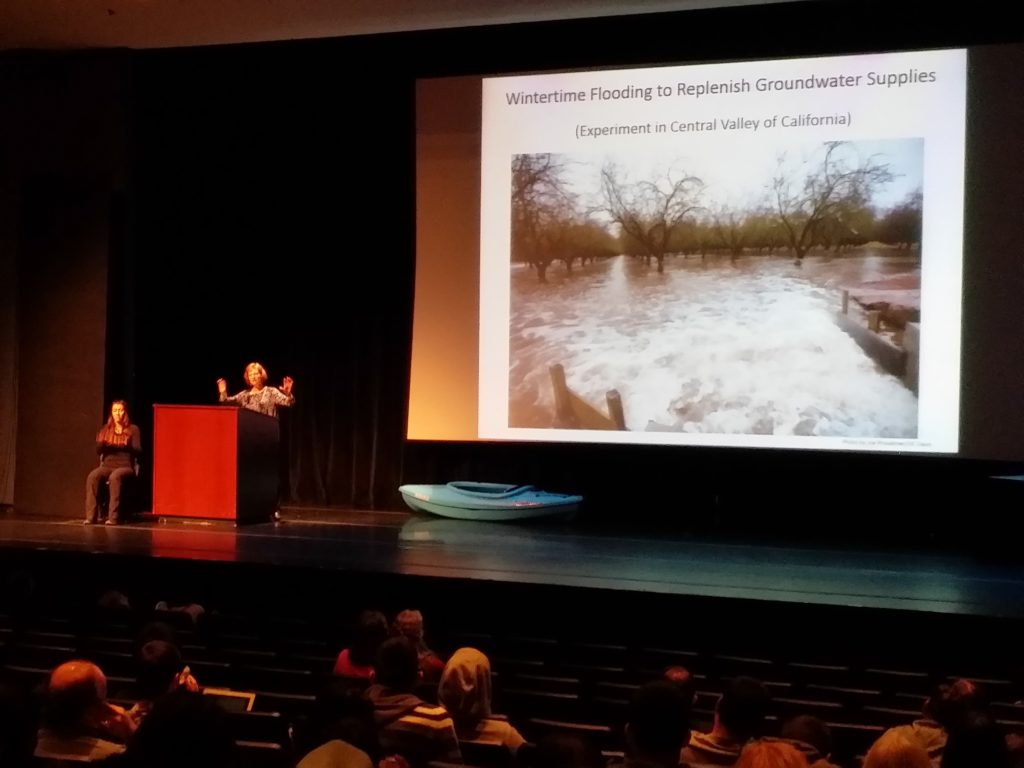
 By KIMBERLY DAVIS
By KIMBERLY DAVIS
“A single processed pizza uses 300 gallons of water,” stated Sandra Postel of National Geographic at the April 25 Northern Virginia Community College (NVCC) Green Festival.
This small, but compelling and relatable example captured the theme of the festival, We are all downstream. The diverse group of students and guests in attendance also visited the booths of participating vendors and employers that are active in the “green space”, and many watched a screening of the important recent film about marine pollution, Plastic Oceans.
“Clearly, we need to figure out how we can live happy, healthy, productive lives, while shrinking our water footprint, just as we are doing with our carbon footprint,” Postel added.
A crisis of the world’s own making
The World Economic Forum is sounding the alarm – water crises are the top global risk over the next decade. Competition for this essential and highly localized resource is aggravating geopolitical conflict in already stressed environments.

While this unsustainable use of water has been clear for some time, climate change is accelerating the water scarcity challenge. Watershed equilibrium is shifting, due to the increase in precipitation as rain, instead of being stored as snow and released during spring melts. In addition, there are fewer but more intense storms. Rainfall patterns are shifting geographically, and areas affected by drought spawn mega-fires that further alter runoff and watersheds. Meanwhile, the pressure is on to pump groundwater to meet domestic, agricultural, and industrial needs, in some areas to the point of depletion.
Because one tenth of the world’s population still lacks access to clean water, countries around the world are facing increased challenges in water supply planning for both volume and purity, clearly a critical issue for public health and safety.
But it is not viable policy to only increase supply to meet increased demand; the demand side of water use must also be managed.

Currents of change
In this context, it is encouraging to see many leaders, professionals, and consumers working on water planning, across disciplines and across the globe. Just as agriculture is seeking to produce “more crop per drop”, businesses are increasingly applying the principle of water use efficiency, up and down the supply chain. Once one acknowledges the supply chain risks posed by water scarcity, there is clearly a business case for investing in water efficiency.
Companies are figuring out how to work with nature to return water to the area it was taken from, not just moving it further and further downstream.
And most importantly, they are better calibrating the use of water to the true needs of the supply chain, leaving the rest to sustain the natural environmental water cycle. Of course, more remains to be done to create an economy that is truly circular when it comes to water, and the involvement of many stakeholders to address these challenges is key.
There are also a variety of public sector initiatives to try to improve the availability and quality of water. The heartening images of children playing in a shallow stream showcased an important, though short-term, binational U.S. – Mexico border project to restore some of the minimal flow of the Colorado River, reported Postel. The border region is one of the most water-scarce regions in the Western Hemisphere, and such cooperative and collaborative initiatives will be vital to ensuring there is enough of this precious finite resource to share.

Read more:
- Annandale Hosts Annual Green Festival – a recap article from NVCC
- Thirst for Power: Energy, Water, and Human Survival – 2016 book by Michael E. Webber that discusses the long-term sustainability of energy and water
- Change the Course – a U.S. initiative to restore water in ecosystems
- Quiz from the U.S. Geological Survey on how much water it takes to produce common goods
- Infographic on water usage for different foods
- Lessons from the Development of Binational and Civil Society Cooperation on Water Management at the U.S.-Mexico Border – Mexico Institute
- Water: The Other U.S.-Mexico Border Issue – Stratfor
Kimberly Davis applies compliance and policy solutions in environmental and urban infrastructure planning. With a background in water, wastewater, and stormwater, Kimberly’s focus has been in renewable energy since 2007, and she is President of a consulting firm. Kimberly is a graduate of Trinity University in San Antonio, TX, and received a Masters in Urban Planning from New York University.
Photos courtesy of Janine Finnell unless otherwise noted.
Leaders in Energy is building a community of engaged leaders to create a sustainable energy system, economy, and world. The three main pillars of engagement are green jobs, impactful leadership, and actionable solutions for sustainable communities. More information is available at https://www.leadersinenergy.org and in the Leaders in Energy Research, Communication, Policies & Analysis (LERCPA) LinkedIn group.


Leave a Reply